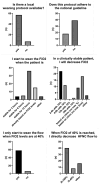High-flow nasal cannula oxygen therapy for children with bronchiolitis: Implementation of a national guideline
- PMID: 39736092
- PMCID: PMC12066921
- DOI: 10.1111/apa.17566
High-flow nasal cannula oxygen therapy for children with bronchiolitis: Implementation of a national guideline
Abstract
Aim: High flow nasal cannula (HFNC) therapy is a form of respiratory support used in children with bronchiolitis. A national guideline for the use of HFNC was published in The Netherlands in 2020. We studied the implementation and use of this guideline.
Methods: We performed a multicentre observational study amongst all hospitals in the North-West part of The Netherlands referring to the same paediatric intensive care unit (PICU). This study consisted of two parts: a comparison of local HFNC protocols to the national guideline and a survey about the use of HFNC amongst paediatricians in the participating centres.
Results: We observed considerable variations between the local protocols and the national protocol, especially regarding criteria to initiate HFNC treatment and weaning practices. Survey results showed that expectations of HFNC widely varied, while the clinical use of HFNC deviated from both the national guideline as well as local protocols, especially for weaning practices and the use of pCO2 as a parameter for initiation and evaluation of the effect of HFNC.
Conclusion: Implementation of the national guideline for HFNC therapy in bronchiolitis was inefficacious, leading to non-uniform clinical practice.
Keywords: bronchiolitis; guideline; high flow nasal cannula therapy; implementation; paediatric intensive care unit.
© 2024 The Author(s). Acta Paediatrica published by John Wiley & Sons Ltd on behalf of Foundation Acta Paediatrica.
Conflict of interest statement
The authors declare no conflicts of interest.
Figures
References
-
- Franklin D, Babl FE, Schlapbach LJ, et al. A randomized trial of high‐flow oxygen therapy in infants with bronchiolitis. N Engl J Med. 2018;378:1121‐1131. - PubMed
-
- Franklin D, Babl FE, George S, et al. Effect of early high‐flow nasal oxygen vs standard oxygen therapy on length of hospital stay in hospitalized children with acute hypoxemic respiratory failure: the PARIS‐2 randomized clinical trial. JAMA. 2023;329:224‐234. https://jamanetwork.com/journals/jama/fullarticle/2800430 - PMC - PubMed
-
- Winer JC, Mertens EO, Bettin K, McCoy E, Arnold SR. Variation and outcomes of hospital‐level high‐flow nasal cannula usage outside of intensive care. Hosp Pediatr. 2022;12:1087‐1093. https://pubmed.ncbi.nlm.nih.gov/36443240/ - PubMed
-
- Kooiman L, Blankespoor F, Hofman R, et al. High‐flow oxygen therapy in moderate to severe bronchiolitis: a randomised controlled trial. Arch Dis Child. 2023;108:455‐460. https://pubmed.ncbi.nlm.nih.gov/36941030/ - PubMed
-
- Gutiérrez Moreno M, Del Villar GP, Medina A, et al. High‐flow oxygen and other noninvasive respiratory support therapies in bronchiolitis: systematic review and network meta‐analyses. Pediatr Crit Care Med. 2023;24:133‐142. - PubMed
Publication types
MeSH terms
LinkOut - more resources
Full Text Sources
Medical


